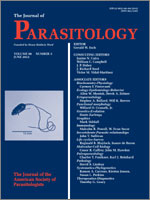The helminth fauna of the largest bathyergid, the Cape mole-rat (Bathyergus suillus) was studied throughout an entire calendar year. The species richness encountered was low, with only 3 species of nematodes (Longistriata bathyergi, Mammalakis macrospiculum, and Trichostrongylus sp.) and 2 species of cestodes (Taenia sp. and Rodentolepis sp.). At less than 10%, the prevalence for all helminths species was similarly low and may be a result of the solitary lifestyle and the subterranean habitat exploited by this rodent. Clear seasonal patterns were apparent for the most common nematode (L. bathyergi), and prevalence and abundance were highest among non-pregnant females compared to males and pregnant females. Dispersal patterns associated with the mating system of the host could explain this pattern. In contrast, the prevalence of the most common cestode (Taenia sp.) was neither determined by season nor host sex, suggesting that foraging habits may constantly expose B. suillus to this parasite.
How to translate text using browser tools
1 June 2012
Determinants of Helminth Infection in a Subterranean Rodent, the Cape Dune Mole-Rat (Bathyergus suillus)
Heike Lutermann,
Nigel C. Bennett
ACCESS THE FULL ARTICLE

Journal of Parasitology
Vol. 98 • No. 3
June 2012
Vol. 98 • No. 3
June 2012




